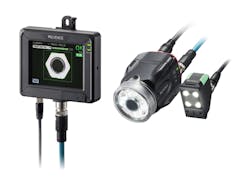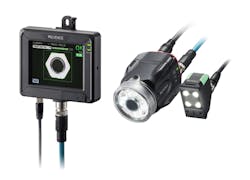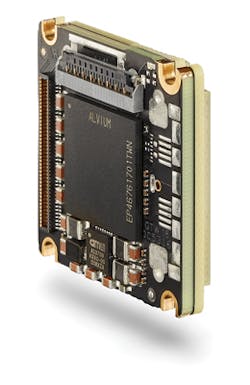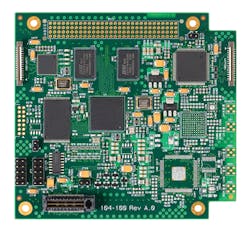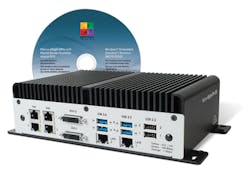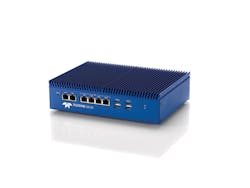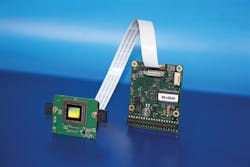Low-cost peripherals target embedded systems designers
Highly integrated camera modules and processors are lowering the cost of building embedded vision systems.
While the definition of an embedded vision system remains vague, it is generally accepted that such systems typically fall into four categories. These consist of smart cameras that embed processors, lighting, software and I/O into a single product, embedded “vision processors” that incorporate processors, I/O and software tailored to vision systems developers, low-cost system on-a-chip (SOC) modules based on bus interfaces and form factors such as PCI Express or deeply-integrated embedded vision systems such as home security systems tailored for single-application, mass-market production.
In every case, embedded systems leverage the power of low-cost processors, peripherals, interface standards, and often open-source image processing and machine vision software to lower the cost of machine vision and image processing systems. At the same time, the reduced footprint of such systems allows them to be incorporated into products such as automobiles, drones, hand-held medical devices and low-cost intelligent security systems.
Adding smarts to cameras
For developers of systems targeted at factory automation applications, the introduction of smart cameras has allowed multiple imaging stations to perform pass/fail decision making, I/O part rejection and networked management capability at numerous stages of the production line process (see “Smart cameras challenge host-based systems in industrial applications,” Vision Systems Design, September 2017; http://bit.ly/VSD-SCC).
Interestingly, as with many other aspects of vision system design, system’s developers can follow one of two paths. The first is to opt for smart cameras such as the Vision Sensor IV series from Keyence (Osaka, Japan; www.keyence.com) shown in Figure 1, the FQ2 Series from Omron (Kyoto, Japan; www.omron.com) and the VE Series from Banner Engineering (Minneapolis, MN, USA; www.bannerengineering.com) that use proprietary software to perform specific machine vision and image processing tasks.
Figure 1: Smart cameras such as the Vision Sensor IV series from Keyence use proprietary software to perform specific imaging tasks.
Alternatively, developers can choose cameras such as the NEON-1021 from ADLINK Technology (New Taipei, Taiwan; www.adlinktech.com) that support a number of software packages including MERLIC and HALCON from MVTec (Munich, Germany; www.mvtec.com), Common Vision Blox from Stemmer Imaging (Puchheim Germany; www.stemmer-imaging.com), VisionPro from Cognex (Natick, MA, USA, USA, www.cognex.com), MIL from Matrox Imaging (Dorval, QC, Canada; www.matrox.com), Sherlock from Teledyne DALSA (Waterloo, ON, Canada; www.teledynedalsa.com) as well as open-source packages such as OpenCV (https://opencv.org).
>>> GET PRICING.
For example, at the 2018 Embedded Vision Summit held from May 21-24 in Santa Clara, CA, USA, Vision Components (Ettlingen, Germany; www.vision-components.com) showcased its latest embedded vision products including the VC LibQ machine vision library that combines a machine vision library powered by HALCON with embedded systems such as its VCSBC Nano Z OEM board or housed cameras. The ARM/Linux smart cameras are based on a Zynq dual core ARM Cortex A9 module (2 x 866 MHz) with integrated FPGA from Xilinx Inc. (San Jose, CA, USA; www.xilinx.com), and are now available with Sony Pregius CMOS image sensors (IMX252).
The trade-off with open-source is the level of support required. But, for those wishing to develop low-cost application specific, royalty free applications, the engineering investment required to develop custom applications using third-party cameras and open-source software may well be worthwhile. Indeed, just as smart camera vendors have lowered the cost of factory automation systems, camera vendors themselves have recognized the opportunities presented by embedded applications.
To do so, companies such as Allied Vision (Stadtroda, Germany; www.alliedvision.com) and Basler (Ahrensburg, Germany; www.baslerweb.com) have both introduced intelligent camera modules that off-load functions such as noise reduction and color de-bayering to on-board processors while reducing the size and weight associated with traditional housed machine vision cameras.
Allied Vision’s 1 series, for example, uses the company’s own Alvium embedded vision processor that supports OpenCV and features both a MIPI CSI-2 and USB3 Vision interface (Figure 2) while Basler’s dart camera modules employ Snapdragon SoCs from Qualcomm (San Diego, CA, USA; www.qualcomm.com) and MIPI CS-2 and USB 3 interfaces.
Figure 2: Allied Vision’s 1 series camera modules feature an on-board processor and offer a more compact design than housed cameras.
While such camera modules support mobile camera interfaces such as MIPI CSI-2 and those more commonly found in PC and machine vision systems such as USB 3, a number of other analog and digital camera interfaces exist. These include legacy analog broadcast standards such as NTSC, PAL, digital standards such as RGB and HDMI interfaces as well as GigE, Camera Link and CoaXPress.
Processor boards and interfaces
While the choice of which camera interface is important, as important is the choice of which processor board used to support the camera and camera interface. To reduce the size (and cost) of these processors and the I/O required to build an embedded system, the developer can follow three different approaches.
The first is to choose an open standard such as PC/104 and its derivatives that allow numerous types of boards including frame grabbers, processors and I/O modules to be stacked to form an embedded compact computer system (see “Small-form-factor frame grabbers enable embedded applications,” Vision Systems Design, February 2013; http://bit.ly/VSD-SFF).
Today, a number of different incarnations of the original PC/104 standard exist including the original PC/104 developed in 1992, PC/104-Plus, PCI-104, PCI/104-Express and PCIe/104 all of which are offered in a 90 × 96 mm form factor. As the latest versions of the PC/104 standard, the PCI/104-Express and PCIe/104 both incorporate the PCI Express bus (PCIe). However, while the PCI/104-Express specification incorporates the PCI Express bus (PCIe) and the PCI bus, PCIe/104 boards do not feature the legacy PCI bus, thus increasing the real-estate available on the board.
Many frame grabber companies support the PCI-104 bus in all its incarnations with a number of different products that support a variety of camera interfaces. For PC/104-Plus designs, Active Silicon (Iver, UK; www.activesilicon.com) offers its Phoenix PC/104-Plus that supports Base Camera Link configurations and Sensoray (Tigard, OR, USA: www.sensoray.com) offers its legacy PAL, SECAM, NTSC, RS-170, four-input Model 311 frame grabber.
Incorporating the latest generation PCIe/104 standard, the HDGrabberX Series boards from Advanced Micro Peripherals (Witchford, UK, www.ampltd.com) can be used to capture HDMI/DVI, RGB, and HD-SDI while both Epix (Buffalo Grove, IL, USA: www.epixinc.com) and Euresys (Angleur, Belgium; www.euresys.com) have targeted the machine vision market with boards that support the Camera Link and CXP standards respectively (Figure 3).
Figure 3: Incorporating the latest generation PCIe/104 standard, (a) the HDGrabberX Series boards from Advanced Micro Peripherals can be used to capture HDMI/DVI, RGB, and HD-SDI while (b) Euresys has targeted the machine vision market with boards that support the CXP standard.
These boards can be combined with a number of other PCIe/104-based CPU, I/O and expansion boards from companies such as Connect Tech (Guelph, ON, Canada; www.connecttech.com) to allow developers to build machine vision and image processing systems in small form factor configurations.
Rather than choose a multi-stack architecture such as PC/104, embedded designers can now choose from a host of Computer On Modules (COM) with which to implement embedded designs. With the functionality of embedded computers, COM boards usually lack the I/O required to implement I/O and thus usually need to be mounted onto a carrier board to provide the I/O functionality required. Here, numerous standards exist with which to develop embedded systems.
These include the COM Express from the PCI Industrial Computer Manufacturers Group (PICMG; Wakefield, MA; USA; www.picmg.org), CoreExpress originally developed by LiPPERT Embedded Computers (Mannheim, Germany, www.lippertembedded.com) and standardized by the Small Form Factor Special Interest Group (Santa Clara, CA, USA; www.sff-sig.org) and the Qseven, a COM that integrates core components of a PC onto a form factor of 70mm x 70mm or 40mm x 70mm from the Standardization Group for Embedded Technologies (Munich, Germany; www.sget.org). A complete list of these and other computer form factors can be found at http://bit.ly/VSD-CFF.
>>> GET PRICING.
To build a system using processors based on these COMs, carrier boards are often used to supply the necessary I/O. Since many of these carrier boards feature standard interfaces such as PC/104, frame grabbers can be easily added to them. However, as John Hentges of ACCES I/O Products (San Diego, CA, USA; www.accesio.com) points out in his article “mPCIe Takes on Shrinking Footprints/Growing Challenges,” that can be found at http://bit.ly/VSD-mPCI, such interfaces are large compared to the modern PCI Express Mini Card (mPCIe).
An example of a carrier board that supports this interface is the COM Express Type 10 Mini Carrier Board from Connect Tech. With an 84mm x 55mm form factor, the boards’ interfaces include two Gigabit Ethernet ports, six USB ports and DisplayPort/HDMI/DVI/VGA display interfaces as well as two mini PCIe slots.
For the developer of embedded image processing systems, a number of frame grabbers are available that can support various types of camera interfaces ranging from broadcast standards such as NTSC and PAL through to digital standards such as HD-SDI and machine vision camera interfaces such as Camera Link. Some of the most popular currently available mPCIe cards are listed below in Table 1.
Manufacturer | Website | Product name | Camera interface |
Advanced Micro Peripherals Witchford, UK | www.ampltd.com | AVC8000nano | 8 Live NTSC/PAL video inputs Drivers for Windows, Linux |
AverMedia Taipai City, Taiwan | CM313B | HD video capture with 3G-SDI input H.264 H/W encoding Mini-PCIe | |
EPIX | PIXCI EB1mini | Base Camera Link Frame Grabber | |
HaSoTec GmbH Rostock, Germany | FG-38-III | Mini PCI Express Frame Grabber Eight composite inputs Four Y/C inputs | |
HC-38 | Camera Link Mini PCI Express Frame Grabber | ||
HD-38 | HD-SDI / HDSDI Mini PCI Express Frame Grabber | ||
Imperx Boca Raton, FL, USA | HD-SDI Mini-PCIe | SD and HD-SDI input formats for 720p,1080 and 1080p video | |
Sensoray | Model 1012 | 8 NTSC/PAL inputs captured to YUYV, UYVY, RGB555, or RGB565 |
Table 1: For the developer of embedded image processing systems, a number of mPCIe card frame grabbers are available that can support various types of camera interfaces ranging from broadcast standards such as NTSC and PAL through to digital standards such as HD-SDI and machine vision camera interfaces such as Camera Link.
While systems designers can choose from a range of baseboards and add-in modules with which to implement an embedded imaging or machine vision system, several companies now offer off-the-shelf hardware that perform much of the functionality required.
These include the Jetson TK1 from NVIDIA (Santa Clara, CA, USA, www.nvidia.com), a $192 embedded Linux development platform (https://elinux.org/Jetson_TK1) that features a Tegra K1 SOC, USB and HDMI ports and a mPCIe card slot, the NXP i.MX 8MQuad Evaluation Kit (EVK) from NXP Semiconductors (Eindhoven, The Netherlands; www.nxp.com), that integrates a 10/100/1000 Ethernet port, USB 3.0 connectors and PCIe interfaces and the DragonBoard 820c development board from Qualcomm that features USB, GigE and MIPI CSI camera interfaces.
Other small form factor computers that include the MIPI CSI interface include the Raspberry Pi 3 Model B+ single board computer developed by the Raspberry Pi Foundation (Cambridge, UK, www.raspberrypi.org) that has been used in numerous embedded designs including most recently the design of a fundus camera (see “Low-cost components make portable fundus cameras a reality,” Vision Systems Design, April 2018, http://bit.ly/VSD-LCE).
Vision processors
While considering such low-cost hardware implementations, designers of machine vision systems must carefully trade-off the software investment required to develop their systems. While open-source software packages such as OpenCV are useful, they are unsupported and those involved in deploying embedded vision systems may require the support offered by more vision vendors of both hardware and software. Recognizing this need, established vendors such as Cognex, Matrox Imaging, and Teledyne DALSA all offer smart cameras and embedded PC-based vision systems that can be configured for machine vision applications.
By choosing such an approach over lower-cost hardware-only implementations, systems developers can develop custom image processing and machine vision applications using pre-configured hardware and high-level graphical user interface (GUI) based software that can be easily configured. Cognex’s In-Sight VC200 vision system, for example, supports four In-Sight Gigabit Ethernet/PoE cameras, I/O, Ethernet and USB ports and the company’s In-Sight vision tools that allow machine vision programs to be graphically configured.
Similarly, Matrox Imaging offers its 4Sight GPm line of vision controllers with its Design Assistant integrated development environment (IDE). Equipped with up to four Gigabit Ethernet/POE ports, four SuperSpeed USB ports, the system features discrete I/Os and USB ports for factory automation applications. Finally, the GEVA industrial controller from Teledyne DALSA features a dual-core processor, and Gigabit Ethernet camera interfaces, display, USB ports, dedicated trigger inputs for inspection timing, dedicated strobe outputs for lighting control and can be configured with the company’s iNspect or Sherlock application software (Figure 4).
Figure 4: For developers of machine vision systems, Matrox offers its 4Sight GPm line of vision controllers with its Design Assistant IDE (a). For its part, Teledyne DALSA offers the GEVA industrial controller that features a dual-core processor, and Gigabit Ethernet camera interfaces and can be configured with the company’s iNspect or Sherlock application software (b).
Today, developers of embedded systems have a range of hardware and software choices when developing their systems. For those experienced in all the many aspects of hardware, software, optical and mechanical design, low-cost embedded products can be realized for less than $1,000 in volume applications such as drones, robotics and automotive applications. Where high-level application support for more complex inspection tasks may be required, however, developers may wish to opt for companies more intimately involved with both machine vision hardware and software.
Figure 5: The VCSBC Nano Z OEM board-level smart camera from Vision Components runs a Linux-based operating system that allows users to develop their own applications with Open CV or use the VC LibQ machine vision library powered by HALCON.
>>> GET PRICING.
Companies mentioned
ACCES I/O Products
San Diego, CA, USA
Active Silicon
Iver, UK
www.activesilicon.com
ADLINK Technology
New Taipei, Taiwan
Advanced Micro Peripherals
Ely, UK
Allied Vision
Stadtroda, Germany
Banner Engineering
Minneapolis, MN, USA
Basler
Ahrensburg, Germany
Cognex
Natick, MA, USA
Connect Tech
Guelph, ON, Canada
Epix
Buffalo Grove, IL, USA
Euresys
Angleur, Belgium
Keyence
Osaka, Japan
LiPPERT Embedded Computers
Mannheim, Germany
Matrox
Dorval, QC, Canada
MVTec
Munich, Germany
NVIDIA
Santa Clara, CA, USA
NXP Semiconductors
Eindhoven, The Netherlands
Omron
Kyoto, Japan
OpenCV
PCI Industrial Computer Manufacturers Group (PICMG)
Wakefield, MA, USA
Qualcomm
San Diego, CA, USA
Raspberry Pi Foundation
Cambridge,UK
www.raspberrypi.org
Sensoray
Tigard, OR, USA
Stemmer Imaging
Puchheim Germany
Small Form Factor Special Interest Group
Santa Clara, CA, USA
Standardization Group for Embedded Technologies
Munich, Germany
Teledyne DALSA
Waterloo, ON, Canada
Vision Components
Ettlingen, Germany
Xilinx Inc.
San Jose, CA, USA
About the Author

Andy Wilson
Founding Editor
Founding editor of Vision Systems Design. Industry authority and author of thousands of technical articles on image processing, machine vision, and computer science.
B.Sc., Warwick University
Tel: 603-891-9115
Fax: 603-891-9297
